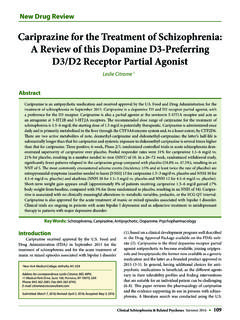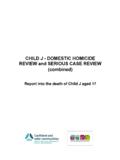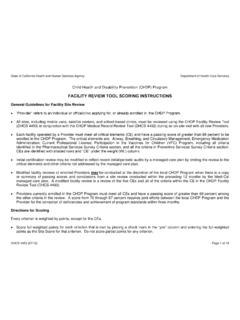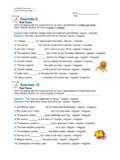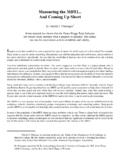Transcription of Iloperidone for the Treatment of Schizophrenia: An …
1 Iloperidone is a second-generation atypical antipsychotic whose primary mechanism of action is within the subclass of combined D2/5HT2A antagonism. Iloperidone was approved by the FDA in May 2009 for the Treatment of schizo-phrenia. This review is a comprehensive synthesis of the history and clinical trials data leading up to approval, and evaluates Iloperidone within the clinical context of how it compares with other available antipsychotics. New Drug ReviewIloperidone for the Treatment of Schizophrenia: An Updated Clinical Review 1 Department of Psychiatry, University of Illinois at ChicagoAddress for correspondence: Peter J. Weiden, MD, Professor Psychiatry, University of Illinois at Chicago Medical Center, MC 913, 912 South Wood Street, Chicago, IL 60612-7327E-mail: October 11, 2011; Revised: January 12, 2012; Accepted: January 26, 2012 Peter J.
2 Weiden 1 Key Words: Iloperidone , Psychopharmacology, Antipsychotic, Extrapyramidal Side EffectsAbstractIntroduction Iloperidone is a second-generation atypical anti-psychotic whose primary mechanism of action is within the subclass of combined D2/5HT2A antagonism, with greater affinity for the 5HT2A receptor than D2 recep-tor antagonism (1). Iloperidone received FDA approval in May 2009 for Treatment of adults with schizophrenia, and became available in the United States for use in early 2010. At the time of this review (early 2012), Iloperidone is only approved and available for prescription in the Iloperi-done s benzisoxasole chemical structure and D2/5HT2A re-ceptor affinity profile places Iloperidone in the [xyz]done family (risperidone, ziprasidone, paliperidone) (2).
3 Because the pronunciation of Iloperidone is phonetically similar to paliperidone, it is worth emphasizing that Iloperidone is not the same as paliperidone, and Iloperidone is not a me-tabolite or derivative of any other available antipsychotic. Although Iloperidone and other antipsychotics share a high affinity for both D2 and 5HT2A receptors, Iloperidone has other binding affinities that give it a unique receptor bind-ing fingerprint. In particular, Iloperidone has a high af-finity for the dopamine D3 receptor and very strong affin-ity for the noradrenergic A1 receptor. Iloperidone has low affinity to serotonin 5HT1A, dopamine D1 and histamine H1, and muscarinic receptors (3-7).
4 One might predict from this binding that Iloperidone will not have significant antihistaminic or anticholinergic side effects, but will have significant side effects related to its alpha-adrenergic recep-tor antagonist properties. Less predictable from its pharma-codynamic profile is that Iloperidone has a more favorable extrapyramidal symptoms (EPS) and akathisia profile than other D2/5HT2A antagonists. Other reviews have excellent summaries of the pharmacodynamic and pharmacokinetics of Iloperidone (8). This review will focus more on how to use Iloperidone in clinical practice, and its advantages and disadvantages relative to other antipsychotics available.
5 Efficacy of Iloperidone The clinical trials program is summarized in Table 1, which forms the primary reference point for later discus-sions and recommendations on using Iloperidone in clinical 34 Clinical Schizophrenia & Related Psychoses April 2012 Peter J. WeidenClinical Schizophrenia & Related Psychoses April 2012 35 Table 1 Summary and Timeline of Iloperidone Pivotal StudiesStudy (Sponsor) (ref #s)Study 1(Novartis; 3000) (18, 24, 25)Study 2(Novartis; 3001*) (26)Study 3(Novartis; 3002*)Study 4(Novartis; 3003*)Study 5(Novartis;3004)(18, 24, 25)Study 6(Novartis;3005 )(18, 25)Study 7(Vanda; 3101 ) (27)
6 Study Start DateOctober 1998 January 1999 January 1999 February 1999 June 1999 April 2000 November 2005 Site Location Countries United StatesAustria, Czech Republic, France, Germany, Hungary, Israel, Poland, and SwitzerlandEgypt, Hong Kong, Indonesia, Malaysia, the Philippines, Singapore, Taiwan, and ThailandArgentina, Brazil, Chile, Colombia, and , Australia, Belgium, Canada, France, Hungary, and South , Canada, Croatia, Germany, Hungary, Israel, Poland, and South AfricaUS and IndiaPrimary Goal of StudyAcute efficacy and dose were 6- week , acute, head-to-head studies that were used to enter patients into a 1- year relapse (doses)Comparator (doses) Iloperidone (4 mg, 8 mg, 12 mg);haloperidol (15 mg).
7 For both acute and maintenance, Iloperidone flexible dose (4 16 mg/day).At 6 weeks, the mean doses of Iloperidone and haloperidol were mg/d and mg/d, respectively. Iloperidone 4 8 mg/day; 10 16 mg/day;risperidone4 8 12 16 mg/day;20 24 mg/day;risperidone (6 8 mg/day).24 mg/day Iloperidone ; ziprasidone 160 mg/day. Efficacy 4 and 8 mg did not separate from placebo; 12 mg > placebo. Iloperidone comparable to haloperidol in both the 6- week acute studies and in relapse prevention. Both dose ranges > placebo. Both doseranges >placebo (FDA analysis). Iloperidone > placebo. Comment Early study showing 4 and 8 mg subtherapeutic for acute treat-ment of schizophrenia.
8 PANSS total improvement for 12 mg dose of Iloperidone was vs. for haloperidol. Patients who met criteria for acute response during the 6- week trial were continued on their blinded study medication ( Iloperidone , n=359; halo-peridol, n=114). These subjects continued for up to one year in maintenance-phase Treatment ; primary outcome was time until (pending) relapse. Hazard ratio of time to relapse for Iloperidone vs. haloperi-dol subjects was (95% CI, ; p= ). Mean time to relapse between Iloperidone and haloperidol ( days vs. days, respectively; p= ). Dur-ing the long-term maintenance phase, the discontinuation rates were the same for Iloperidone and haloperidol ( ).
9 BPRS improvement of for risperidone vs. lower-dose Iloperidone and higher-dose Iloperidone . The higher dose of Iloperidone and risperidone >placebo. Initial analysis of the lower Iloperidone dose only showed trend level dif-ferences from placebo, but FDA re-analysis, excluding schizoaf-fective patients, found that Iloperidone 12 16 mg/day was more effective than placebo. Similar uptitration periods for Iloperidone and ziprasidone; ziprasidone > placebo; Iloperidone and ziprasidone about the same efficacy. *The regulatory objective of these three studies (3001, 3002, 3003) was to support approval for maintenance Treatment of schizophrenia.
10 However, the FDA did not accept a noninferiority design as adequate evidence for a maintenance indication. Therefore, at this time, Iloperidone is only labeled for the acute Treatment of schizophrenia. The actual study design was a noninferiority comparison so, strictly speaking, a statement of comparable short-term or long-term efficacy goes beyond the initial study objectives. However, the degree of symptom improvements and the K-M survival curves for time to relapse are very similar and seem comparable to most observers. These two studies (3005 and 3101) were formally accepted by the FDA as the two pivotal trials being positive for efficacy of Iloperidone for the Treatment of schizophrenia.

